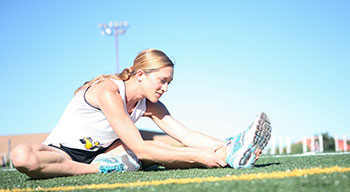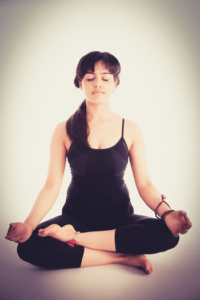
You know breathing is important, this is not big news to anyone. But did you know that the simple act of breathing can help boost your metabolism, relieve stress and burn fat?
We’ve talked about how to utilize proper breathing techniques to ensure you’re getting the most out of every breath. Now we are going to look at why you should really make sure that you’re using those techniques to reap major benefits.
In order to get all of the bonuses of breathing when exercising, you need to remember to do it properly. This involves following the 3:2 method. Simply put, breathe in for 3 steps and out for 2 steps. If you are exercising at a higher intensity switch it up to 2:1, breathe in for 2 steps and out for one.
This ensures you are taking in the oxygen you need and expelling the carbon dioxide that you need to get out. You can learn more about how to breathe and what happens each time you do from our last article.

While the idea that you can breathe out fat may sound crazy, it’s actually true! A study published in the British Medical Journal investigated where the fat actually goes when you are losing weight, and found that we are breathing some of it out.
It is important to note that this applies to the stored fats in the body, known as triglycerides. Triglycerides are formed when our body stores the excess carbohydrates and protein from our diet in fat cells.
The team studied the molecular makeup of these triglycerides, which are formed of carbon, hydrogen and oxygen. They found that when broken down they become carbon dioxide and water.
According to the team’s calculations, for every 10kg of fat that is broken down, 84% of that becomes carbon dioxide which you exhale when you breathe out.
When you are not exercising you aren’t going to be seeing major results from this, but you will when you are exercising. During exercise you are also increasing your metabolism, which means you are breaking down and breathing out fat at a much higher rate, up to 20%!
When we talk about your metabolism, we are talking about your body’s ability to convert the nutrients in your food into energy, which can be used.
Oxygen plays a key role in your metabolism. Basically, your body can’t make energy without it!
The process by which your body turns food into energy is called the Kreb’s Cycle. Your body uses the oxygen that you breathe to carry nutrients to the places that need it. Once there, the oxygen helps break down the nutrients into carbon dioxide and energy that your body uses.
When you are exercising, you are using a lot more energy. To produce this energy you need to be taking in more oxygen, which is when your proper breathing techniques are key.
By taking in more oxygen your body can produce energy more efficiently, so you can exercise longer to burn more calories and store less fat.

Oxygen not only plays vital roles when you are exercising, but is also an important part of your post-workout routine.
It can be so easy to rush through stretching after a workout…and end up sore the next day. If you take a little more time and incorporate proper breathing into your stretching, your muscles will thank you!
According to the Massachusetts Institute of Technology, breathing while you stretch relaxes the body, helps reduce lactic acid buildup, and improves circulation.
With each breath you take, your body is carrying oxygen-rich blood to your muscles. This oxygenated blood helps improve the elasticity of your muscles so that you can elongate your muscles, improve flexibility and avoid muscle soreness after a workout.
To make sure that you are giving your muscles the attention they need, there are a few things to keep in mind.
Don’t rush – Take a little time in each stretch. You don’t need to be camping out in each stretch for an extended period, but you do need to hold it for a minimum of 30 seconds. This gives your body time to circulate oxygenated blood to your muscles so that it can do its job.
Breathing while stretching – When you are stretching, especially when your muscles are tight and it hurts a little, it’s really easy to forget about your breathing. You may even realize that you are holding your breath without thinking about it.
Thankfully, there is an easy technique that will keep your breathing in the forefront of your mind and also get you the most out of your stretch. When you are in position, take a deep breath in without moving your body. When you exhale, let your body settle into the stretch. Repeat this process. Stay where you are while you inhale and then stretch a little deeper on the exhale.

There are so many things every day that cause us to feel stressed, we certainly don’t need to add any more. However, did you know that improper breathing can actually increase your stress level?
Most of us do what is known as “chest breathing”, we simply don’t take the time to consciously breathe deeply. When you aren’t taking full, deep breaths you aren’t filling your lungs to their capacity. This means part of your lungs aren’t getting their share of oxygen which can lead to anxiety.
You can beat this by invoking a relaxation response using a technique developed in the 1970’s by Dr. Herbert Benson, a cardiologist at Harvard Medical School. It’s very simple.
Find a comfortable place to sit or lay down.
Breathe in slowly through your nose, letting your chest and belly rise and expand as your lungs fill completely.
Breathe out slowly through your mouth or nose (whichever is more natural) until your lungs are empty.
Repeat. Try doing this for 10 minutes, practice makes perfect!
Not only will you feel your stress loosen its grip, this will also slow your heartbeat and lower your blood pressure.
Whether you are headed to the gym, jumping on your elliptical, or just taking a quiet moment to yourself, remember your breathing. You’ll see and feel the difference in your mind and your body.
When somebody loses weight, where does the fat go? Ruben Meerman, researcher, Andrew J Brown, professor; 2014
Why Is Breathing Important During Stretching? Dana Tuffelmire;
Relaxation techniques: Breath control helps quell errant stress response: April 2018